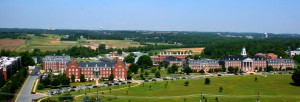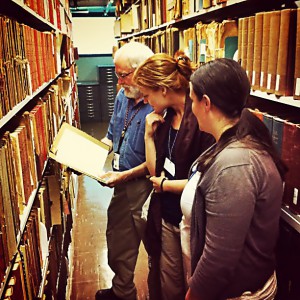Hidden Treasures: The USDA Agricultural Research Service. Part 1: The National Agriculture Library
I had the good fortune last month of visiting the U.S. Department of Agriculture’s (USDA’s) Agricultural Research Service (ARS) station in Beltsville, MD. What I found there was truly inspiring: large projects devoted to improving organic agricultural practices, a treasure trove of information stored in the National Agriculture Library, and researchers passionate about their work. The amount of information and work stored at the Beltsville ARS station is too much to go over in one blog post, so I will be breaking it up into two parts: my morning exploring the services available at The National Agriculture Library and, after lunch, my tour of some of the research happening in the ARS field plots.
Part 1: The National Agriculture Library
 Beltsville Agricultural Research Center
Beltsville Agricultural Research Center
My day started with a tour of The National Agriculture Library (NAL) from Bill Thomas and Katie Winkleblack, two NAL staff members who know more about sustainable agriculture resources than Google. As they guided me through the stacks of beautiful old books and crumbling newspapers, they told me about their data digitization initiative. Katie has been directly involved with this project to scan entire books into a digital, searchable format. This is good news for people who aren’t able to stop into the NAL facilities in person. Soon, much of the information held within their walls will be available online!
NAL also produces and collaborates on a lot of resources for farmers, researchers, and consumers that many people do not know about. One of my favorite programs that Bill described was the USDA's Organic Literacy Initiative. This project connects organic farmers (and prospective organic farmers) with USDA resources targeted to the specific interests and needs of the user. NAL was part of a USDA-wide team that compiled this helpful set of guides and interactive training as a way to connect those in need of greater information about the organic program to the foundation.
 In the stacks of the USDA National Agricultural Library with Bill Thomas and Katie Winkleblack.
In the stacks of the USDA National Agricultural Library with Bill Thomas and Katie Winkleblack.
As a researcher, I also make use of their annotated bibliographies quite a bit. One bibliography, Tracing the Evolution of Organic and Sustainable Agriculture, covers topics from Pest Management to Water, and leads to summaries of all the USDA research done in those areas all the way back to the 1700’s.
For farmers interested in examining methods for addressing agrarian challenges without the use of synthetic chemicals, NAL provides a website called Organic Roots. This site centers around agricultural research performed before the heavy use of synthetics. All the 800 historic documents available in this collection were published before 1942.
A few other gems available on NAL’s website include a directory of U.S. colleges and universities that have programs focusing on sustainable, and an Oral History Interview Series that documents the experiences of some of the most influential and inspiring individuals in the field of alternative agriculture.
If you happen to be in the Beltsville area, I would highly recommend stopping in to NAL to talk with their staff. You’ll also be able to see some beautiful agricultural art on display, including the USDA Pomological Watercolor Collection.

